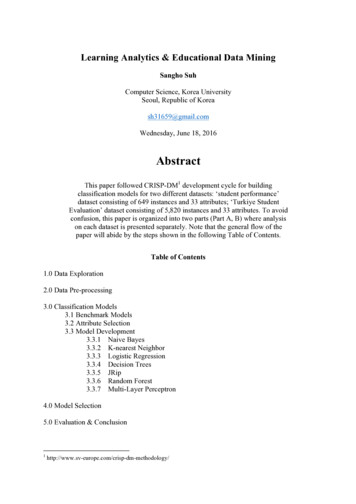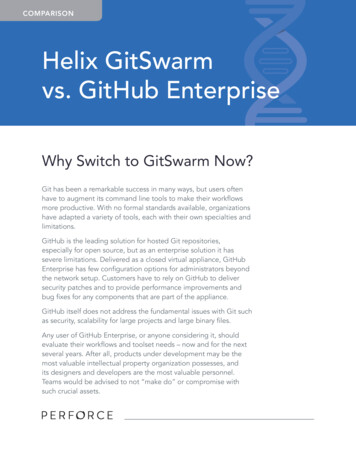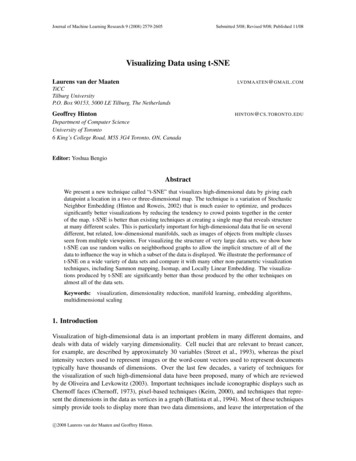
Transcription
Learning Analytics & Educational Data MiningSangho SuhComputer Science, Korea UniversitySeoul, Republic of Koreash31659@gmail.comWednesday, June 18, 2016AbstractThis paper followed CRISP-DM1 development cycle for buildingclassification models for two different datasets: ‘student performance’dataset consisting of 649 instances and 33 attributes; ‘Turkiye StudentEvaluation’ dataset consisting of 5,820 instances and 33 attributes. To avoidconfusion, this paper is organized into two parts (Part A, B) where analysison each dataset is presented separately. Note that the general flow of thepaper will abide by the steps shown in the following Table of Contents.Table of Contents1.0 Data Exploration2.0 Data Pre-processing3.0 Classification Models3.1 Benchmark Models3.2 Attribute Selection3.3 Model Development3.3.1 Naive Bayes3.3.2 K-nearest Neighbor3.3.3 Logistic Regression3.3.4 Decision Trees3.3.5 JRip3.3.6 Random Forest3.3.7 Multi-Layer Perceptron4.0 Model Selection5.0 Evaluation & dology/
IntroductionThe overall goal of this project is to provide detailed analysis of chosen datasets whilebuilding classification models.For this project, we use the Weka (Waikato Environment for Knowledge Analysis)2 datamining toolkit. This toolkit provides a library of algorithms and models for classifying andanalyzing data.To ensure accuracy, all development and testing of models will follow the CRISP DMprocess. Exploration of the problem Exploration of the data and its information (meta) Data preparation Model development Evaluating outcomesPart A. ‘Student Performance Data Set’1.0 Data Exploration of ‘Student Performance Data Set’A-1. Data Set Information:“This data approach student achievement in secondary education of two Portuguese schools.The data attributes include student grades, demographic, social and school related features)and it was collected by using school reports and questionnaires. Two datasets are providedregarding the performance in two distinct subjects: Mathematics (mat) and Portugueselanguage (por). In [Cortez and Silva, 2008], the two datasets were modeled under binary/fivelevel classification and regression tasks. Important note: the target attribute G3 has a strongcorrelation with attributes G2 and G1. This occurs because G3 is the final year grade(issued at the 3rd period), while G1 and G2 correspond to the 1st and 2nd period grades. Itis more difficult to predict G3 without G2 and G1, but such prediction is much more useful(see paper source for more details).”3The attribute information4 is as follows.# Attributes for both student-mat.csv (Math course) and student-por.csv (Portuguese language course)datasets:1 school - student's school (binary: 'GP' - Gabriel Pereira or 'MS' - Mousinho da Silveira)2 sex - student's sex (binary: 'F' - female or 'M' - male)3 age - student's age (numeric: from 15 to .cs.umass.edu/ml/datasets/Student udent Performance3
4 address - student's home address type (binary: 'U' - urban or 'R' - rural)5 famsize - family size (binary: 'LE3' - less or equal to 3 or 'GT3' - greater than 3)6 Pstatus - parent's cohabitation status (binary: 'T' - living together or 'A' - apart)7 Medu - mother's education (numeric: 0 - none, 1 - primary education (4th grade), 2 – 5th to 9th grade, 3 –secondary education or 4 – higher education)8 Fedu - father's education (numeric: 0 - none, 1 - primary education (4th grade), 2 – 5th to 9th grade, 3 –secondary education or 4 – higher education)9 Mjob - mother's job (nominal: 'teacher', 'health' care related, civil 'services' (e.g. administrative or police),'at home' or 'other')10 Fjob - father's job (nominal: 'teacher', 'health' care related, civil 'services' (e.g. administrative or police),'at home' or 'other')11 reason - reason to choose this school (nominal: close to 'home', school 'reputation', 'course' preference or'other')12 guardian - student's guardian (nominal: 'mother', 'father' or 'other')13 traveltime - home to school travel time (numeric: 1 - 15 min., 2 - 15 to 30 min., 3 - 30 min. to 1 hour, or4 - 1 hour)14 studytime - weekly study time (numeric: 1 - 2 hours, 2 - 2 to 5 hours, 3 - 5 to 10 hours, or 4 - 10 hours)15 failures - number of past class failures (numeric: n if 1 n 3, else 4)16 schoolsup - extra educational support (binary: yes or no)17 famsup - family educational support (binary: yes or no)18 paid - extra paid classes within the course subject (Math or Portuguese) (binary: yes or no)19 activities - extra-curricular activities (binary: yes or no)20 nursery - attended nursery school (binary: yes or no)21 higher - wants to take higher education (binary: yes or no)22 internet - Internet access at home (binary: yes or no)23 romantic - with a romantic relationship (binary: yes or no)24 famrel - quality of family relationships (numeric: from 1 - very bad to 5 - excellent)25 freetime - free time after school (numeric: from 1 - very low to 5 - very high)26 goout - going out with friends (numeric: from 1 - very low to 5 - very high)27 Dalc - workday alcohol consumption (numeric: from 1 - very low to 5 - very high)28 Walc - weekend alcohol consumption (numeric: from 1 - very low to 5 - very high)29 health - current health status (numeric: from 1 - very bad to 5 - very good)30 absences - number of school absences (numeric: from 0 to 93)# these grades are related with the course subject, Math or Portuguese:31 G1 - first period grade (numeric: from 0 to 20)31 G2 - second period grade (numeric: from 0 to 20)32 G3 - final grade (numeric: from 0 to 20, output target)The data set exploration in IPython Notebook as well as attribute information given aboveprovided valuable information regarding the data set. Some of the important discoveries areas follows.l There is a total of 395 instances and 32 attributes.l G3 is the output label. In other words, all 32 attributes other than G3 are independentvariable predicting dependent variable, G3.l G3 has a [0, 20] range. If classification model has to predict 1 class out of the 20possible class labels with only 395 instances, it would be difficult. It seems that thenumber of class labels should be less in order for classification models to showreasonable accuracy.l There are no missing values for any of the given attributes. In fact, from reading theirpaper, I could identify that they also had ‘income’ attribute. In the end, however,they did not include it in the data set, because some left this question blank—as it isprobably a sensitive inquiry. In any case, this makes the dataset robust to preprocessing issues.l There is a mix of numeric and nominal attribute.
l There is a bit of imbalance in the attributes, such as school, address, famsize, Pstatus.l The attributes, such as G1, G2 and G3, exhibit Gaussian distribution, as shown inFig. 1.l Through visualization, G1 and G2 are confirmed to have high correlation with G3,except for very few outliers. Figure 2 illustrates such correlation.G1G2Figure 1. Grade distributionG3G1 vs G3 (class)G2 vs G3 (class)Figure 2. Correlation between G1,G2 and G32.0 Data Pre-processing for ‘Student Performance Data Set’2.1 Change the format from CSV to ARFFThe downloaded data came in csv and R format. Thus, in order to use the data set inWeka, it was pre-processed with python in IPython notebook.The following image is the data as it came in csv format.Figure 3. Original dataset in csv format
With references to python and syntactic structure specified by attribute-relation fileformat(arff)5, which was developed by University of Waikato to use in Weka, the dataset wastransitioned to the following file in arff format.Figure 4. Transformation into arff formatThe following image shows that it was successfully loaded to Weka.Figure 5. Student Performance Data Set on Weka5http://www.cs.waikato.ac.nz/ml/weka/arff.html
2.2 Change the number of target class clustersInitially, the target output class ranges from 0 to 20, and there are 21 clusters (cf.Figure 4). This is an unreasonable setting for the classification task, because it makes itextremely difficult to classify—remember that the number of instances we have is only 395.As a result, I have mapped a group of clusters to a few clusters [1,4], as indicated in Table 1and Figure 6. This now makes classification task a reasonable task.Range of initial class0 56 1011 1516 20New cluster number1234Table 121 class labels4 class labelsFigure 6. Number of target class clusters2.3 Remove outliers from G1 vs G3 and G2 vs G3 graphSince Fig.2 confirms that G1 and G2 have high correlation with G3, I hypothesized that withG1 and G2 alone, it may be possible to get good enough result. Thus, it was assumed thatremoving the outliers in G1 vs G3 graph would help classification. However, removing theoutliers on G1 vs G3 graph resulted in rather significant loss of accuracy, as shown in Table1. This showed that G1 and G2 may not assume such a significant factor in helping to predictG3.DatasetOriginalOutliers (G1 vs G3) removedOutliers (G2 vs G3) removedInstances395357370Accuracy (J48)79.49%38.38%39.73%Table 23.0 Classification Models for ‘Student Performance Data Set’In order to find a classifier algorithm(s) to best generalize the data, this sectionconcentrates on identifying various classifiers, identifying which work better than othersand choosing the most efficient algorithms and further refining their parameters further to
increase their generalization accuracy. Note that all the accuracy was calculated using 10-foldcross validation.3.1 Benchmark ModelsSeveral models were chosen and applied to the sample dataset. These models include,Naive Bayes, k-nearest neighbor, Logistic regression, J4.8, RandomForest, OneR, JRip,ZeroR. Each algorithm was applied using its default parameters. K-nearest neighbor’s k valuewas chosen by user, and this chosen value is displayed on each table where appropriate. Thealgorithm with best accuracy is underlined.ModelNaïve Bayesk-nearest neighbor (k 4)Logistic regressionJ4.8JRipRandomForestMulti-Layer PerceptronZeroR .01%67.59%42.78%3.2 Attribute SelectionAs mentioned above, first reasonable assumption starts with identifying the extent to whichG1 and G2 have influence on G3. However, as we have confirmed in Figure 2, G1 and G2alone cannot be a significant factor for predicting G3.In order to understand which attributes play an important role, we referred to a treestructure generated by J4.8, as shown in Fig. 5. In detail, the tree had 30 leaves and 59 as itssize. The analysis reveals that G2 is the most significant attribute (as expected); it is the rootnode (cf. Figure 7). This is reasonable, as G2 is the test score students receive before G3.Obviously, students who do well on the previous test will do well on the next test, as it can beassumed that the test contents may be related. Even if not, it is a good indicator that a studentis preparing for his or her exams well.In any case, examination of the tree suggested that attributes, such as age, activities,failures, have minimal influence—you can see them at the lowest node, while attributes, G2,absences, G1, traveltime, famrel, are the most important attributes.
Figure 7. Tree generated by J4.8Only using these significant attributes, we attempted classifying seven main modelswith default values and recorded their progress. The algorithm that has performed the best isunderlined.ModelNaïve Bayesk-nearest neighbor (k 4)Logistic regressionJ4.8JRipRandom ForestMulti-Layer %81.77%81.77%83.79%78.73%42.78%Naïve Bayes has increased by more than 6%, while k-nearest neighbor has increased from44.30% to 76.96%. Also, logistic regression increased from 42.78% to 82.03%, with J4.8seeing approximately 2% increase as well. JRip improve by little (0.76%), but overall, theaccuracy has all increased in main models. The bold style indicates that the accuracy hasincreased. Fig. 8 is the tree generated by J4.8 with only five most significant attributes. Thenumber of leaves is 31 and its size is 61, which is not much different from the tree in Fig. 7.But it clearly shows that those five attributes are good discriminants.
Figure 8. Tree generated by J4.8 with five most significant attributes only3.3 Model Development3.3.1 Naive BayesWhen we experimented with all 32 attributes, Naïve Bayes showed 73.92% in accuracy.With five most significant attributes, its accuracy increased to 80.76%.To see if estimation can be improved, we set useKernelEstimator parameter to true. Theaccuracy increased to 81.52%. After that, we applied discretization on the model by settinguseSupervisedDiscretization parameter to true (with useKernelEstimator at false). Theaccuracy was even higher at 82.28%.3.3.2 K-nearest NeighborAs for K-nearest neighbor, the accuracy with k 1 was 41.77%, and the accuracy after k 4did not improve much. Since k-means (at k 1) is equivalent to logistic regression and ZeroR,it is understandable that those three methods outputted accuracy in the similar range (i.e.accuracy within 40 43%).After removing all insignificant attributes and running K-nearest neighbor(k 1) with fivemost significant attributes, the accuracy jumped to 76.96%. K-nearest neighbor at k 10 waseven higher at 79.49%.Note that even with different distance weighting schemes, the accuracy of K-nearestneighbor with all 32 attributes never went beyond 43%. In other words, reducing the numberof variables seem to be the necessary setting if K-nearest neighbor is to be used. Refer toTable 3 for detailed accuracy record.Standard1/distance1-distanceNumber of attributesAccuracy(32 attributes)44.30%42.78%42.78%32 attributesTable 3Accuracy(5 attributes)76.96%75.94%76.96%5
3.3.3 Logistic RegressionAfter testing with five most significant attributes only, the accuracy drastically increased to82.02%, which is the best out of all the models we tested so far. To see if we can improve byvarying ridge parameter, we experimented and was able to see that accuracy only decreasedand that the default value is optimal for getting the best accuracy, as shown in Table 4.Ridge parameter1 x 10-81 x le 43.3.4 Decision TreesDecision Tree was able to improve by getting rid of less significant attributes. Its accuracyincreased from 79.49% to 81.77%, albeit minimal. We experimented with complexity controlto see if the performance can be improved. As indicated in Table 5, setting unprunedparameter to true increased accuracy to 82.78%, which is above the best accuracy by far setby logistic regression above.Complexity ControlunprunedunprunedminNumObj(unpruned true)minNumObjParameter Table 53.3.5 JRipJRip consistently performed well, regardless of whether how many attributes and whichattributes were used. The accuracy was in the range of 81.01% 81.77%. We changed thenumber of folds to see if further improvement can be 1.77%81.77%Table 6
No significant improvement was observed with changes in number of folds.3.3.6 Random ForestRandom Forest is known for its powerfulness. In addition to powerful decision treerepresentation, it is capable of generalizing well. Indeed, it exhibited the best performance(83.79%) by far. Even with various experimentation with parameters in different models, itwas not enough to beat Random Forest.3.3.7 Multi-Layer PerceptronWith attribute selection, Multi-Layer Perceptron improved from 67.59% to 78.73%. MultiLayer Perceptron is a very powerful algorithm suitable for complex non-linear functions. Thereason the performance increase is not as high as any other or that the performance is notshown to be the best seems to rely on the fact that the classifier for this dataset does not haveto be complex. This result is reasonable, because the relationship between the influentialattributes and student performance is most likely linear.4.0 Model SelectionThough no single model stands above all the other models by high margin, it is clear thatRandom Forest beats all the other models in performance. Since Random Forest is robust tooverfitting, it is a satisfying choice for our classifier.5.0 Evaluation & Conclusion for ‘Student Performance Data Set’The experiment with the student performance data set was gratifying in that it provided mewith a chance to take a shot at educational data mining. While this experiment andexamination was very extensive, I think much more interesting insights can still be minedfrom this data set. I will leave this as a part of future work.ReferenceP. Cortez and A. Silva. Using Data Mining to Predict Secondary School StudentPerformance. In A. Brito and J. Teixeira Eds., Proceedings of 5th FUture BUsinessTEChnology Conference (FUBUTEC 2008) pp. 5-12, Porto, Portugal, April, 2008,EUROSIS, ISBN 978-9077381-39-7. [Web Link6]S. Harvey. Mining Information from US Census Bureau f
Part B. ‘Turkiye Student Evaluation Data Set’1.0 Data Exploration for ‘Turkiye Student Evaluation Data Set’A. Student Evaluation Data SetA-1. Data Set Information:“This data set contains a total 5820 evaluation scores provided by students from GaziUniversity in Ankara (Turkey). There is a total of 28 course specific questions and additional5 attributes.”7The attribute information8 is as follows.Name of attributeCommentPossible tructor’s identifierCourse codeNumber of times the student is taking this courseCode of the level of attendanceLevel of the difficulty of the courseThe semester course content, teaching method andevaluation system were provided at the start.The course aims and objectives were clearly stated at thebeginning of the period.The course was worth the amount of credit assigned to it.The course was taught according to the syllabus announcedon the first day of class.The class discussions, homework assignments, applicationsand studies were satisfactory.The textbook and other courses resources were sufficientand up to date.The course allowed field work, applications, laboratory,discussion and other studies.The quizzes, assignments, projects and exams contributed tohelping and learning.I greatly enjoyed the class and was eager to activelyparticipate during the lectures.My initial expectations about the course were met at the endof the period or year.The course was relevant and beneficial to my professionaldevelopment.The course helped me look at life and the world with a newperspective.The instructor’s knowledge was relevant and up to date.The instructor came prepared for classes.The instructor taught in accordance with the announcedlesson plan.The instructor was committed to the course and e Student kiye Student 4,5}{1,2,3,4,5}{1,2,3,4,5}
Q17Q18Q19Q20Q21Q22Q23Q24Q25Q26Q27Q28The instructor arrived on time for classes.The instructor has a smooth and easy to followdelivery/speech.The instructor made effective use of class hours.The instructor explained the course and was eager to behelpful to students.The instructor demonstrated a positive approach to students.The instructor was open and respectful of the views ofstudents about the course.The instructor encouraged participation in the course.The instructor gave relevant homeworkassignments/projects, and helped/guided students.The instructor responded to questions about the courseinside and outside of the course.The instructor’s evaluation system (midterm and finalquestions, projects, assignments, etc.) effectively measuredthe course objectives.The instructor provided solutions to exams and discussedthem with students.The instructor treated all students in a right and e data set exploration in IPython Notebook as well as attribute information given aboveprovided valuable information regarding the data set. Some of the important discoveries areas follows.l There is a total of 5,820 instances and 33 attributes.l ‘nb.repeat’ ought to be the output label we predict, the rest are the independentvariables.l There are no missing values for any of the given attributes, so there is no concern orneed for pre-processing the data.l All attributes are numeric.As seen from Fig. 9, most students have ‘re-taken’ the course only once, which seemsreasonable. But this may make our plan to build an interpretable, acceptable classifier a bitdifficult, since the distribution is too skewed. We will confirm later in Section 4.0 but thisskewed distribution may lead a very simple classifier, ZeroR, to exhibit good enoughclassification accuracy.Figure 9. Class distribution (nb.repeat)
Note that the distributions of answers from Q1 to Q28 display similar distribution type(Fig. 10), another factor that may make it difficult for us to select particular attributes forattribute selection.Figure 10. Type of distribution manifest from Q1 to Q28In order to numerically assess whether they really exhibit similar pattern, I first computedpercentage value on each nominal label (i.e. {1,2,3,4,5}) for each attribute from Q1 to Q28.Then, I calculated mean and standard deviation for values from Q1 to Q28. As shown inTable 7, it is clear that the attributes, Q1 Q28, display similar ndard Deviation(STDEV)1.761.821.032.311.75Table 7Range(1 )(15.0,18.5)2.0 Data Pre-processing for ‘Turkiye Student Evaluation Data Set’2.1 Change the format from CSV to ARFFThe downloaded data came in csv and R format. Thus, in order to use the data set inWeka, it was pre-processed with python in IPython notebook.The following image is the data as it came in csv format.
Figure 11. Original dataset in csv formatWith references to python and syntactic structure specified by attribute-relation fileformat(arff)9, which was developed by University of Waikato to use in Weka, the dataset wastransitioned to the following file in arff format.Figure 12. Transformation into arff formatThe following image shows that it was successfully loaded to l
Figure 13. Student Evaluation Data Set on Weka3.0 Classification Models for ‘Turkiye Student Evaluation Data Set’In order to find a classifier algorithm(s) to best generalize the data, this sectionconcentrates on identifying various classifiers, identifying which work better than othersand choosing the most efficient algorithms and further refining their parameters furtherincrease their generalization accuracy.3.1 Benchmark ModelsSeveral models were chosen and applied to the sample dataset. These models included.Naive Bayes, k-nearest neighbor, Logistic regression, J4.8, RandomForest, OneR, KStar,JRip, ZeroR. Each algorithm was applied using its default parameters. K-nearest neighbor’s kvalue was chosen by user, and this chosen value is displayed on each table where appropriate.The algorithm with best accuracy is underlined.ModelNaïve Bayesk-nearest neighbor (k 4)Logistic regressionJ4.8RandomForestJRipMulti-Layer PerceptronZeroR .34%83.04%84.34%3.2 Attribute SelectionThe optimal tree generated by J4.8 has only one node, confirming that blindly selecting asingle class (i.e. nb.repeat 1) without taking any additional information (i.e. attributes)
into account still gives you the best performance. Also, as discussed in Section 1.0, theattribute distribution for Q1 to Q28 shows similar pattern. This implies that particularattributes from the pool (Q1 to Q28) may not be good discriminants. Indeed, as shown in Fig.14, the patterns visible in red panel corroborates the similar in those attributes. Thus, Iexperimented by removing all the questionnaire attributes (Q1 to Q28) and tested theperformance with major algorithms. Thus, the attributes used were ‘instr’, ‘class’,‘attendance’, ‘difficulty.’Figure 14. Classifier errors visualizedThe following is a list of classification accuracy measured using seven main modelswith default values. The algorithm that has performed the best is underlined.ModelNaïve Bayesk-nearest neighbor (k 4)Logistic regressionJ4.8JRipRandom ForestMulti-Layer Perceptron*ZeroR(baseline)Accuracy (computing time)84.24%84.16%84.33% (5 sec)84.34%84.34%83.64% (2 sec)83.73%84.34%After removing insignificant attributes, Naïve Bayes increased by almost 30%, while knearest neighbor has seen only 0.14% increase in performance. Also, logistic regressionincreased by only 1%, with J4.8 and JRip practically seeing no improvement at all. Random
Forest improved by 0.6%. Overall, the accuracy has all increased in main models. The boldstyle in models indicates that the accuracy has increased.3.4 Model Development3.4.1 Naive BayesWhen we experimented with 32 attributes, the accuracy was at 55.72%. However, afterusing just 4 main attributes, Naïve Bayes showed 30% increase to boast the accuracy at84.24%. Given the nature of Naïve Bayes, this clearly demonstrates that the questionnaireattributes (Q1 to Q28) do not serve as supporting information for building a classifier.3.4.2 K-nearest NeighborCompared to when we used 32 attributes, K-nearest Neighbor showed better performancewith just 4 attributes at 84.16%.Standard1/distance1-distanceAccuracy(33 attributes)85.39%85.44%85.46%Table 8Accuracy(4 attributes)84.04%84.04%84.04%3.4.3 Logistic RegressionBuilding a logistic model is computationally very expensive. It took about 5 minutes toconstruct a model with 10-fold cross validation. Since it does not have significant advantageover all the other models, this model has a serious drawback when compared to other models.Note that compared to using larger numbers of attributes, using fewer number of attributesgives computing time advantage while assuring even higher performance. When wecomputed using 32 attributes, it took 45 seconds, but with 4 attributes, the computational timewas only 4 seconds.Time(32 attributes)45 secondsTime(4 attributes)4 secondsTable 9I experimented with different ridge parameters but was not successful at improving thecurrent performance.
Ridge parameter1 x 10-81 x ble 103.4.4 Decision TreesSince Decision Tree follows ZeroR structure, it obviously sees no improvement inperformance. As a result, the performance is the same with ZeroR at 84.34%. Although itwas assumed to be the case that changing the structure from ZeroR would only meandecrease in performance as shown in Table 11, I continued with the experiment of changingcomplexity parameters to see how it affects performance. As expected, the performance onlydecreased.Complexity ControlunprunedunprunedminNumObj(unpruned false)minNumObj(unpruned false)Parameter ble 113.4.5 JRipLike Decision Tree, JRip saw no improvement in performance. I experimented withdifferent folds but saw no significant improvement in accuracy, as shown in Table 30%84.34%Table 123.4.6 Random ForestRandom Forest witnessed minor improvement, increasing from 83.09% to 83.64%.Random Forest is very powerful, because it is robust to overfitting. In this case, however,since the dataset distribution is very skewed and simple, Random Forest seemed to be morethan enough.
3.4.7 Multi-Layer PerceptronThe computational time with 32 attributes was too costly. It took almost 45 minutes to justcalculate accuracy with 10-fold cross-validation. Since it did not produce an outstandingperformance (obviously, since the classifier does not need to be complex), Multi-LayerPerceptron is definitely not a fitting algorithm for this data set. As shown in Table 13,however, it was a wise decision to select few important attributes, because it saved us 40minutes with even better performance.Time(32 attributes)Approx. 45 minutes.Time(4 attributes)Approx. 4 minutesTable 134.0 Model SelectionIn this experiment, it was clear that no algorithm can outperform the baseline method,ZeroR, which performes at 84.34%. So the best model is ZeroR in this case.5.0 Evaluation & Conclusion for ‘Turkiye Student Evaluation Data Set’Identifying and understanding what each attribute means was more interesting than theactual experiment itself, because the result was too obvious and did not propose anyinteresting insight. It would have been better, therefore, to have chosen a different attribute asa class. As a part of future work, it will be interesting to choose a different class, such as‘attendance’, ‘instr’, and examine the relationship between these classes and other attributes.ReferenceHajizaden et al. (2014). Analysis of factors that affect students’ academic performance - DataMining Approach. IJASCSE, Volume 3. Issue 8.Gunduz, G. & Fokoue, E. (2013). UCI Machine Learning Repository [Web Link10]. Irvine,CA: University of California, School of Information and Computer iye Student Evaluation#
APPENDIXFigure A. CRISP-DM(Cross-industry process for data dology/
2.0 Data Pre-processing for ‘Student Performance Data Set’ 2.1 Change the format from CSV to ARFF The downloaded data came in csv and R format. Thus, in order to use the data set in Weka, it was pre-processed with python in IPython notebook. The following image is the data as it cam










